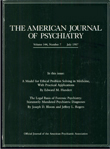Posttraumatic stress disorder among frontline soldiers with combat stress reaction: the 1982 Israeli experience
Abstract
One year after the 1982 Lebanon War, the authors assessed the prevalence, type, and severity of posttraumatic stress disorder in a large representative sample of Israeli soldiers who had been treated for combat stress reactions. Comparisons were made with a group of soldiers who had fought in the same battles but had not been treated for this reaction. A dramatically higher percentage of soldiers with combat stress reaction (59%) than of soldiers without combat stress reaction (16%) developed posttraumatic stress disorder. Age was significantly associated with posttraumatic stress disorder. The authors discuss the differential quality of posttraumatic stress disorder among both groups as well as the factors facilitating recovery.
Access content
To read the fulltext, please use one of the options below to sign in or purchase access.- Personal login
- Institutional Login
- Sign in via OpenAthens
- Register for access
-
Please login/register if you wish to pair your device and check access availability.
Not a subscriber?
PsychiatryOnline subscription options offer access to the DSM-5 library, books, journals, CME, and patient resources. This all-in-one virtual library provides psychiatrists and mental health professionals with key resources for diagnosis, treatment, research, and professional development.
Need more help? PsychiatryOnline Customer Service may be reached by emailing [email protected] or by calling 800-368-5777 (in the U.S.) or 703-907-7322 (outside the U.S.).



